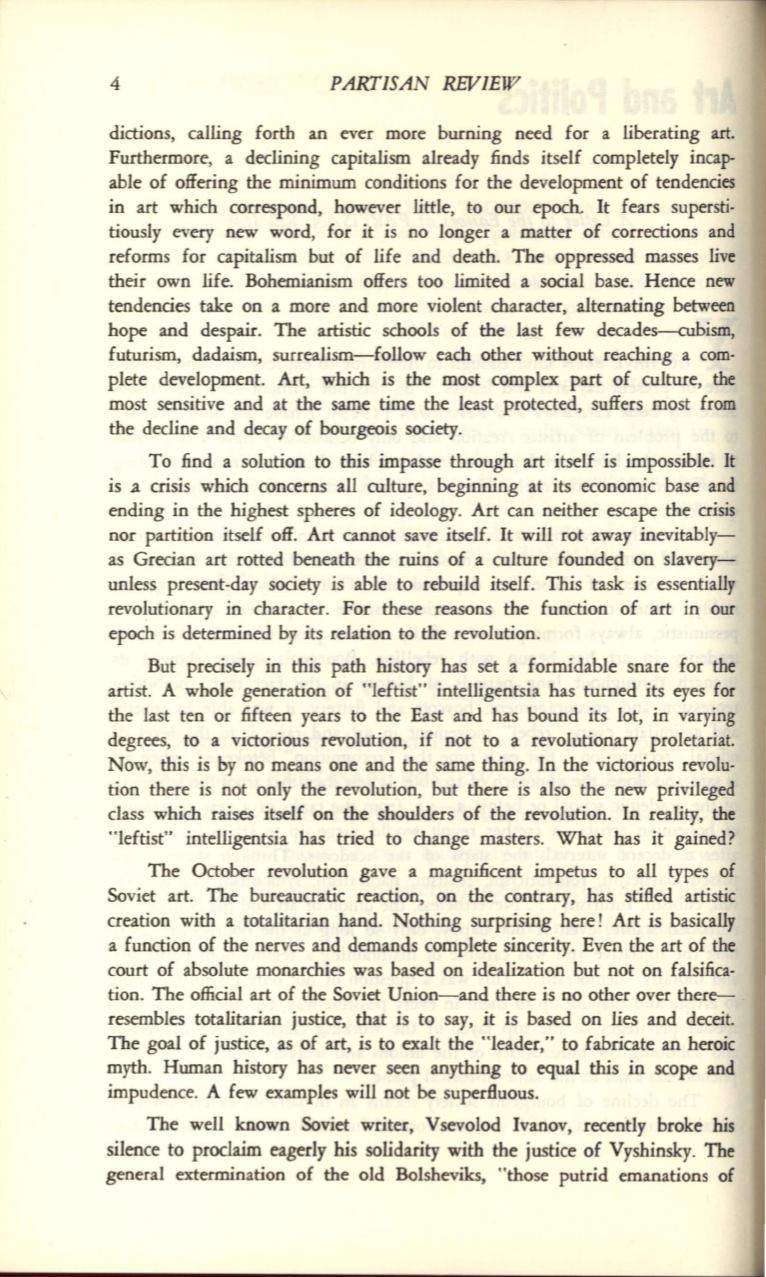
4
PARTISAN REVIEW
dictions, calling forth an ever more burning need for a liberating art.
Furthermore, a declining capitalism already finds itself completely incap–
able of offering the minimum conditions for the development of tendencies
in art which correspond, however little, to our epoch.
It
fears supersti.
tiously every new word, for it is no longer a matter of corrections and
reforms for capitalism but of life and death. The oppressed masses live
their own life. Bohemianism offers too limited a social base. Hence new
tendencies take on a more and more violent character, alternating between
hope and despair. The artistic schools of the last few decades-cubism,
futurism, dadaism, surrealism-follow each other without reaching a com–
plete development. Art, which is the most complex part of culture, the
most sensitive and at the Same time the least protected, suffers most from
the decline and decay of bourgeois society.
To find a solution to this impasse through art itself is impossible.
It
is a crisis which concerns all culture, beginning at its economic base and
ending in the highest spheres of ideology. Art can neither escape the crisis
nor partition itself off. Art cannot save itself. It will rot away inevitably–
as Grecian art rotted beneath the ruins of a culture founded on slavery–
unless present-day society is able to rebuild itself. This task is essentially
revolutionary in character. For these reasons the function of art in our
epoch is determined by its relation to the revolution.
But precisely in this path history has set a formidable snare for the
artist. A whole generation of "leftist" intelligentsia has turned its eyes for
the last ten or fifteen years to the East and has bound its lot, in varying
degrees, to a victorious revolution, if not to a revolutionary proletariat.
Now, this is by no means one and the same thing.
In
the victorious revolu–
tion there is not only the revolution, but there is also the new privileged
class which raises itself on the shoulders of the revolution.
In
reality, the
"leftist" intelligentsia has tried to change masters. What has it gained?
The October revolution gave a magnificent impetus to all types of
Soviet art. The bureaucratic reaction, on the contrary, has stifled artistic
creation with a totalitarian hand. Nothing surprising here! Art is basically
a function of the nerves and demands complete sincerity. Even the art of the
court of absolute monarchies was based on idealization but not on falsifica–
tion. The official art of the Soviet Union-and there is no other over there–
resembles totalitarian justice, that is to say, it is based on lies and deceit.
The goal of justice, as of art, is to exalt the "leader," to fabricate an heroic
myth. Human history has never seen anything to equal this in scope and
impudence. A few examples will not be superfluous.
The well known Soviet writer, Vsevolod Ivanov, recently broke his
silence to proclaim eagerly his solidarity with the justice of Vyshinsky. The
general extermination of the old Bolsheviks, "those putrid emanations of


